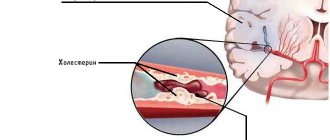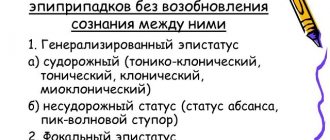Painful conditions associated with disruption of the nervous system are common. But not all pathologies are considered a life sentence. There are a number of them in which the prognosis for recovery reaches 70% or higher. These include episyndrome.
Neither an adult nor a child is immune from such a violation. If an attack occurs for the first time, you should react to it correctly and think about what factors could have caused the deterioration. It is extremely important to take into account the entire medical history.
Causes
Key sources of problems in adults include:
- Post-traumatic consequences of damage to the cranial area.
- Tumor processes in the head region.
- Fainting or syncope as a consequence of a heart rhythm disorder.
- Parasitic lesion or abscess of the brain.
- Collapse.
- Hippocampal sclerosis.
If a seizure occurs in a child, symptomatic epilepsy is explained by the following effects:
- Oxygen starvation of the brain or asphyxia.
- Significant increase in body temperature.
- Ingestion of toxic substances into the body.
- Potassium-calcium imbalance.
- Hormonal imbalance.
- An infection dangerous to the head structures, meningitis.
Manifestations of the disease in young children and adolescents are much more pronounced than in adults. This feature is due to insufficient maturity and continued formation of the nervous system.
Therapy for focal epilepsy
Treatment of focal epilepsy is prescribed by a neurologist and epileptologist, and includes taking anticonvulsants. Anticonvulsants include: carbamazepine, topiramate, phenobarbital, levetiracetam, etc. For the treatment of parietal and occipital epilepsy, pharmacotherapy will be sufficient. In case of focal temporal lobe epilepsy, after 1-2 years of therapy, resistance to anticonvulsant treatment may occur. If there is no effect from therapy, the doctor prescribes surgery.
The operation is performed by neurosurgeons and is aimed at complete removal of the focal formation (malformation, tumor, cyst) or partial removal of the epi-site. Focal resection is used if the focus of epileptic activity is well localized. If cells that are also a source of epileptic activity are adjacent to the epileptogenic zone, then extended resection is prescribed.
How does it manifest itself?
Dangerous signs in a child include the following external changes:
- Hoarseness, shortness of breath.
- Pallor of the skin.
- Headache of various origins.
- Uncharacteristic curvature of the joints of the limbs.
- Impaired consciousness.
- The appearance of foam on the lips.
- Convulsive contraction of the facial muscles, which gradually spreads to the entire body. A striking symptom of episyndrome is the rhythm of convulsions.
Such attacks are called focal. The type of disorder is determined by the location of the affected area. Complex cases with loss of consciousness characterize the episyndrome in children; among adults, a simple course is most often observed.
ICD-10 classification
Let's start with ICD-10 [1] - the leading official classification on which statistical recording, expert decisions, prescription of subsidized drugs, etc. are based.
First of all, it is surprising why in an official document for Russia, instead of the euphonious scientific term “attack,” the stigmatizing term “seizure” is used. Obviously, when ICD-10 was translated into Russian, such ethical nuances were simply not thought about.
In addition, in some points the epileptic syndrome, seizures, form of epilepsy, etiology of epilepsy, localization or generalization are brought together, i.e. there is an intersection of concepts. Thus, the general scientific principles of classification are violated. In the description of epilepsy, terms with unclear meaning are used that are difficult for a practicing physician to understand: “others,” “other specified forms,” “other types,” “special syndromes,” “specified,” “unspecified.” With this approach, the basis for classification is completely absent, opening up a wide field for arbitrary interpretation. How can you treat something if it is “unspecified”? This is similar to putting a criminal with an “unspecified appearance” on the international wanted list.
Thus, there is an overlap of concepts in ICD-10; the sum of the classification members does not equal the volume of the generic concept; subclassification is not continuous; there are no classification grounds, instead of which non-operational terms are introduced: “other”, “special”, “specified”, “unspecified”.
Forms of the disease
Symptomatic epilepsy is classified into frontal, temporal, parietal, and occipital. Depending on the affected area, an expansion of the clinical picture of the disease is noted.
Frontal form
Focal attacks are aggravated by the presence of the following symptoms:
- Motor disorders of the limbs, distortion of half the face.
- Sign of the supplementary motor cortex. It consists of a sharp tension in the arms and legs, and their attraction to the body. Spontaneous outbursts are possible.
- Opercular symptoms: drooling, chewing, smacking, rolling of the eyeballs.
- Adversive disorders with twitching of the head, its removal to the side.
The list is supplemented by partial attacks, including inadequate olfactory reactions, autonomic failure, and motor automatism. After two minutes, there is a transition from focal manifestations to generalized ones.
Temporal form
This variant of pathology is characterized by the following disorders:
- Auditory hallucinations - squeaking, noise, buzzing in the ears.
- Unreasonable sensations of the smell of gasoline, burnt rubber, paint.
- Visual impairment. The main symptom is incorrect display of the proportions of objects.
- Feeling of deja vu.
- Autonomic failure, which is manifested by rapid heartbeat, increased sweating, nausea, abdominal pain, fever.
- Obsessions.
- A sharp transition from an overly joyful state to a depressed one.
- Sleepwalking.
If there is an isolated disturbance of consciousness, a frozen gaze, wide open eyes, they speak of an amygdala-hippocampal lesion. With the lateral type of temporal lobe epilepsy, speech and hearing are additionally affected.
Parietal form
This variant of the episyndrome is distinguished by a number of manifestations:
- During anterior parietal attacks, certain parts of the body go numb and temporary parasthesia occurs.
- If the posterior areas are affected, impaired consciousness is accompanied by freezing with a gaze frozen at one point.
- During lower attacks, the clinical picture consists of dizziness and disorientation in space.
Occipital form
In addition to visual hallucinations, patients experience loss of visual fields and rapid blinking. Additionally, the eyeballs may twitch.
Symptoms of focal epilepsy
Focal epilepsy is characterized by partial focal epileptic paroxysms. Paroxysms can be simple, not accompanied by loss of consciousness, and complex, without loss of consciousness. Simple partial epileptic seizures can be vegetative, somatosensory, motor, sensory, with a hallucinatory component and with mental disorders.
Complex partial epileptic seizures may begin as simple ones, but then damage consciousness occurs. There may be confusion after a seizure.
Secondarily generalized partial seizures begin as a simple or complex focal seizure, but then the excitation spreads to other parts of the cerebral cortex. Thus, the paroxysm takes on a clonic-tonic appearance. The patient may experience various types of partial paroxysms.
Symptomatic focal epilepsy is accompanied by symptoms that correspond to the underlying brain lesion. This type of epilepsy is characterized by decreased intelligence, delayed mental development and impairment of the child’s cognitive sphere.
Idiopathic focal epilepsy is benign and is not characterized by disorders of the mental and intellectual spheres.
Episyndrome and epilepsy, what is the difference
In epilepsy with chronic damage to the nervous system, the factor that provokes seizures is increased discharges in the brain neurons. To which the body reacts with simple or complex seizures, convulsive damage to both the local area and all muscles. The high probability of death is due to hypoxia and accompanying acidosis developing against the background of increased activity. As a result of respiratory arrhythmia, the brain begins to swell, microcirculation is disrupted, which leads to a coma.
The difference between epilepsy and episyndrome is that the second option is not characterized by a chronic course. The source of the problem is age-related vascular changes, injuries, tumors, and brain abscesses. If the attack was isolated, the prognosis is extremely favorable, long-term remission occurs in at least 70% of patients, subject to adequate therapy and prevention.
Pathogenesis of focal epilepsy
The causes of the development of focal epilepsy are: developmental defects that affect a limited area of the brain (cerebral arteriovenous malformations, focal cortical dysplasia, congenital cerebral cysts, etc.), traumatic brain injuries, infections (brain abscess, encephalitis, neurosyphilis, cysticercosis), vascular system disorders (previous hemorrhagic stroke), metabolic encephalopathy, brain tumors. In PE, one of the etiological factors with preserved morphology of neurons and the medulla as a whole may be acquired and genetically determined metabolic defects of neurons in a certain zone of the cerebral cortex.
Perinatal lesions of the central nervous system are the leading cause among the factors causing focal epilepsy. Such lesions are: fetal hypoxia, asphyxia of the newborn, intracranial birth injury, intrauterine infections. The appearance of a focal pathological focus in childhood may be associated with impaired cortical maturation.
The pathophysiological basis of FE is the epileptogenic focus, in which several zones are distinguished. The zone of pathological damage corresponds to the area of morphological changes in cerebral tissue, which can be recorded using MRI.
The primary zone is the part of the cerebral cortex in which epi discharges are generated.
The symptomatogenic zone is the area of the cortex, when excited, an epileptic attack occurs. The irritative zone is an area that is recorded on the EEG during the interictal interval and is the source of an epileptic seizure.
The zone of functional deficit is the area responsible for the neurological disorders that accompany epileptic seizures.
Diagnosis of the disease
If the final diagnosis of the patient’s condition indicates “episyndrome,” the research process is just beginning and it is too early to talk about the final verdict. Two methods are considered the most informative:
- Based on the use of X-rays.
- Using a strong magnetic field.
Both techniques help to recognize the presence or absence of brain lesions. As an additional study, an encephalogram is prescribed to record the attacks themselves and detect their location.
During diagnosis, a number of patients with episyndrome are not diagnosed with pathological disorders, while periodic seizures recur. This condition is considered as presumably symptomatic epilepsy.
Classification of focal epilepsy
There are symptomatic, idiopathic and cryptogenic forms of focal epilepsy. In the symptomatic form, it is possible to establish the source and cause of the pathology, as well as identify morphological changes that are recorded during tomographic studies.
A feature of cryptogenic PE is that, despite its secondary nature, none of the existing imaging methods is capable of identifying morphological abnormalities in the structure of the brain.
Idiopathic PE is not characterized by brain defects typical for this group of pathologies. The substrate for its development, as a rule, is a hereditary predisposition: genetically determined channelopathies, defects in the membranes of CNS cells, dysgenesis of the cerebral cortex. The prognosis for this disease is favorable, the course is benign. Idiopathic FE includes: benign rolandic epilepsy, childhood occipital Gastaut epilepsy, Panagiotopoulos syndrome, benign occipital epileptic syndromes.
Treatment options
The choice of treatment tactics is based on several factors, including age, probable cause, and individual course of the attack. Adult patients are offered the following regimen:
- For long-term use, medicinal herbs with a relaxing effect are prescribed. These are wild rosemary, violet, oregano, celandine, linden.
- Plan a diet with limited consumption of liquids, pickles, and smoked foods.
- Prescribed drugs with anticonvulsant and tranquilizing effects. Their purpose is to reduce the frequency of attacks and muscle relaxation, respectively.
Treatment of children involves the following stages:
- Organizing a diet with an emphasis on fatty foods and reducing the amount of protein. Thanks to this diet, lipids become the body's only energy resource. The reduction in the number of seizures occurs due to the active work of internal structures on the formation of ketone bodies.
- Restoration of calcium-potassium balance.
- Herbal medicine using the medicinal plants mentioned above.
The main goal of treatment is to relieve the underlying cause. Only in this case it is possible to eliminate disability, get an effective result and a normal, fulfilling life.
First aid during an attack
In case of a repeated attack or the initial manifestation of the disease, it is sometimes possible to do without an ambulance. If the patient’s consciousness is preserved, they sit him down and ask him about his general well-being. Subject to an adequate assessment, serious measures may not be applied. When there is an unconscious state, adhere to the sequence below:
- Place the adult or child on his back with his head slightly raised (you can use folded clothes). This precaution will help prevent blows and cranial injuries in the event of convulsions.
- A handkerchief is placed in the mouth to prevent tongue biting.
- If there is excessive salivation, turn the head to the side to avoid choking.
- You need to be prepared for a possible one-minute apnea. The situation is under control when breathing resumes after a couple of seconds.
Errors in providing first aid include bringing a person with a seizure to consciousness, stopping a seizure with mechanical forces. Such measures will not give the expected result (just like forcibly opening clenched teeth).
The duration of one attack is on average 3 minutes, during which the main goal of first aid is to exclude injury, maintain the correct position of the tongue, and prevent hypoxia. If you feel better, you can’t get up immediately - you need to maintain a 10-minute interval. Calling an ambulance is justified in the following situations:
- The patient is a woman expecting a baby.
- The attack occurred in an elderly person or a child.
- The duration of the seizures exceeds 3 minutes.
- Unconsciousness persists after 10 minutes.
Introduction
Classification is the division of a set of objects on a certain basis into types, which are further divided into subspecies, etc.
The basis of division can be significant (natural classification), for example, table D.I. Mendeleev, and unimportant (auxiliary classification), for example, an alphabetical catalog.
The main purpose of classification is to determine the place of objects in the system and establish connections between them.
The nature of the classification depends on its purpose. For example, from the point of view of a housewife who has not read the works of Darwin and Lamarck, all fish existing on our planet are divided into edible and inedible.
For a doctor, classification should primarily have practical significance. Thanks to it, he should receive specific diagnostic and treatment algorithms.
Currently, the main classifications in epileptology are the following: ICD-10 (International Statistical Classification of Diseases and Related Health Problems) and ILAE 2017 (International League Against Epilepsy Classification).










